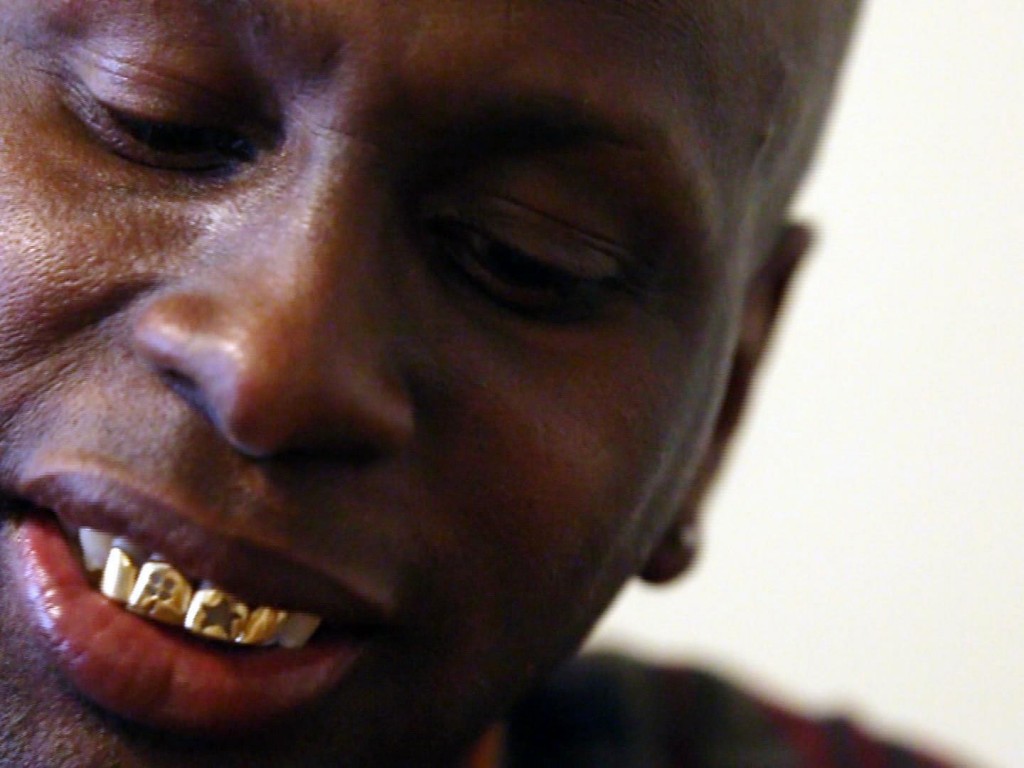February 19, 2015
Prisoners Sentenced
to Life as Kids
Just Lost Their
Best Chance
for Freedom
How the criminal justice system
failed George Toca—and
1,500 others like him
Feb. 19 — There are an estimated 1,500 people in the U.S. serving a sentence of life without the possibility of parole for crimes committed while they were juveniles. It’s called JLWOP and in 2012 the Supreme Court ruled the sentence was unconstitutional. But the court did not address what to do about the people already serving JWLOP sentences. George Toca was one of them. On Jan. 29, 2015, he was released after signing a plea agreement with the Orleans Parish District Attorney. Bloomberg spent a day with Toca as he experienced his new life on the outside. (Video by Jennafer Savino, David Yim)
The gold caps on George Toca’s teeth don’t fit. Put in when he was 15, they’re now more than three decades old and too small. One of them, shaped like a four-leaf clover, has eroded to four vague white dots on his once-brilliant grill.
Toca, 48, left them in, hoping they would help him get out of prison.
In 1984, when Toca was 17, he was charged with accidentally shooting and killing his best friend, Eric Batiste, during a failed carjacking. Victims picked him out of lineups, despite initial statements to police describing an older, heavier shooter who was at least five inches taller than Toca and who did not have four gleaming gold caps on his top front teeth.
Largely on the basis of eyewitness testimony, Toca was convicted of second-degree murder in 1985 and given a mandatory sentence of life in prison without the possibility of parole. He has spent most of the last 31 years in Louisiana’s notorious Angola state penitentiary.
“I thought these [caps] would be my ticket out someday,” he said.
Toca has had an interesting winter. In addition to denying responsibility for his friend’s killing—and working with lawyers at the Innocence Project New Orleans since 2003 to prove his case—Toca appealed to be resentenced based on his age at the time of the alleged crime. The U.S. Supreme Court selects less than 2 percent of the cases presented to it. In December, it agreed to hear Toca’s appeal.
Until recently, the U.S. was the only developed country in the world in which people under 18 could be sentenced to death or to a mandatory sentence of life without parole. For almost a decade, the Supreme Court has chiseled away at laws allowing these sentences. In 2005, the court ruled that juveniles’ “lack of maturity,” susceptibility “to negative influences and outside pressures,” and “transitory, less fixed” personality traits meant they couldn’t be sentenced to death. Following this logic, it ruled five years later that juveniles couldn’t be sentenced to life without parole for non-homicide offenses.
Then, in 2012, in Miller v. Alabama, the court ruled that a mandatory sentence of life without parole, handed down in 29 states’ murder cases as well as those in federal court, is unconstitutional for offenders younger than 18.
The decision left a question on the table: What about those who had already been convicted? Should they be resentenced?
Some states have said that all juveniles sentenced to mandatory life without parole should have a new sentencing hearing. Others—Louisiana, Pennsylvania, Michigan, and Minnesota—have decided against retroactivity. The exact numbers are in dispute, but according to figures from Human Rights Watch and estimates from the Juvenile Law Center in Philadelphia, that means about 1,500 sentences nationwide hang in the balance.
By agreeing to hear and decide Toca’s appeal, the Supreme Court planned to end the uncertainty of those cases.
But in the weeks after the court agreed to hear the case, Toca was approached by Orleans Parish District Attorney Leon Cannizzaro with a tempting offer. Toca had long maintained his innocence in the shooting, but now the D.A. had a deal for him. If he signed a plea agreement admitting to armed robbery, Cannizzaro would drop the original conviction and Toca would be paroled immediately.

The Angola penitentiary is one of the largest prisons in the world with more than 5,000 inmates and two death row units.
Photographer: Sophie Elbaz/Sygma/Corbis
Neither Toca’s lawyers nor Cannizzaro’s office have made specific statements about the timing of the agreement. The D.A.’s office didn’t respond to repeated messages seeking comment.
Sentencing law expert Douglas Berman, a professor at Ohio State University Moritz College of Law, suggests that Toca’s case would have reflected negatively on both Louisiana—whose state Supreme Court decided in November 2013 against retroactivity—and the district attorney’s office, which over the decades had repeatedly fought Toca’s requests for a new trial.
“This was a case where there was some residual uncertainty about guilt—a case in which the victim’s family was supportive of releasing the defendant,” Berman said. (Eric Batiste’s family has long advocated for Toca and said they believe another man killed the teenager.) “I think those are the kind of circumstances that would’ve made a great majority of courts comfortable saying, ‘This is why the rule needs to be retroactive.’ I can see [Cannizzaro’s office] not wanting national attention about any of those issues.”
Toca agreed to the plea deal. Around noon on Jan. 29 he signed the documents. That evening he was a free man, eating a Big Mac at a McDonald’s near his sister’s home in East New Orleans.
With that, those 1,500 cases were again cast into limbo.
On a cool and sunny Friday afternoon this month, near the offices of the Innocence Project New Orleans, Toca was pragmatic about all this. He’d been out of prison just two weeks.
“When I heard I was wanted [for murder] back in ’84, I didn’t flee. I turned myself in. I trusted the system and I wanted to clear my name,” he said, wearing new jeans, a new coat, and new shoes friends and family had bought for him. “Then I was wrongfully convicted and sat in prison 31 years. So when my lawyer came to me and said, ‘You can sign this agreement and leave,’ I was devastated, but I knew I had to sign it. If I didn’t, I knew I was gonna die in Angola.”
Toca’s release was bittersweet. He’s no longer in a cage. He’s catching up with friends on the outside, learning how to use his new smartphone, and looking to find a job. He wants to make something of the landscaping and pest eradication skills he learned as a prisoner, and get paid more than the 20 cents an hour he was making as a kitchen worker behind bars.
Since he agreed to a plea deal, though, the Supreme Court dismissed his case and he is no longer standing in for 1,500 juvenile lifers like him in front of the nation’s highest court.
For those who believe juveniles sentenced to life behind bars should be forced to spend their lives there, Toca’s release is actually good news. “This shows me that the system works,” said Bobbi Jamriska, whose pregnant sister was brutally beaten and stabbed to death in 1993 by a 16-year-old in suburban Pittsburgh. “They went back and they questioned his case and raised their concerns, and [Toca] ended up being let out of jail.”
Jamriska has fought hard to keep both the death penalty and life without parole on the table for juvenile offenders. As Pennsylvania director of the National Organization of Victims of Juvenile Murderers, she said her organization didn’t want Toca’s case in front of the Supreme Court anyway. His case is “an extreme,” she said.
“Even the victim’s family is saying, ‘Get him out of jail,’ ” Jamriska said. “We’d prefer to have a case that’s more representative of some of the horrific crimes juveniles commit.”
She cited the murder of Danni Romig, a 12-year-old girl from Allentown, Pa., who was beaten, raped, and murdered by a 17-year-old boy. The boy had a 23-point handwritten note titled “Things to do when you get a girl in the woods.” It included the instructions “Strip her bare,” “Strip yourself,” and “Slow beat her to death for all pain you had in life”—all tortures he carried out on the sixth-grader. Jamriska said Danni Romig’s murder illustrates that “you need the option of life without parole—you can’t get rid of that.”
The Romig murder itself is an extreme example, Jamriska added. “The next time [the Supreme Court] decides on a case, we hope it picks something in the middle of those extremes,” she said.
Emily Maw, director of Innocence Project New Orleans and Toca’s lawyer, rejects the idea that Toca’s case represents a criminal justice infrastructure working as it should.
“The system did not work for George Toca,” she said. “It utterly failed him for 31 years, ruined his life, and ultimately forced him to plead guilty to a crime he didn’t commit in order to get out of prison.”
She cites Toca’s years of education—a bachelor’s degree earned behind bars, certificates in carpentry and pest eradication—and says he’s not a unique case.
“There are scores and scores of middle-aged and old men who were imprisoned with him in Louisiana, who were sentenced to life as juveniles and who are now among the most rehabilitated prisoners in Louisiana, and likely the country. The system is not working for them either,” she said.
Will the Supreme Court give them another chance?
Marsha Levick, deputy director and chief counsel of the Juvenile Law Center in Philadelphia, believes it will. At least five cases—three in Louisiana, two in Michigan—have been sent for Supreme Court review and could replace Toca’s, but not until the next term at the earliest. That’s in October.
Levick doesn’t blame Toca for his decision.
“First and foremost, good for him,” she said. “I don’t think anybody who has been waiting for the retroactivity issue to be ruled upon would in any way question the decision that George Toca made. How could he not walk out of prison after 30 years?”
For the other juvenile lifers nationwide, “obviously it was disappointing,” she said. “They’re still waiting, just as they have been for 30, 40, 50 years. And they think it’s time for them to get out as well.”
Toca hopes they do, too. Sitting outside with the sun shining above him, he looked down and offered an apology.
“I know they was really relying on my case to get the retroactivity of the Miller case resolved,” he said. “All I can say is, I’m sorry that I let ’em down. This was all I could do.”


